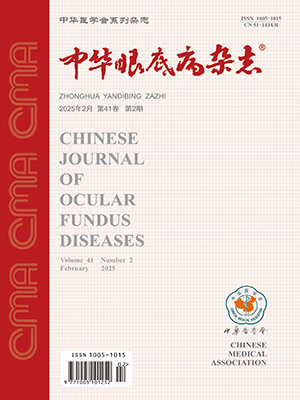| 1. |
Francis PJ. Genetics of inherited retinal disease[J]. J R Soc Med, 2006, 99(4): 189-191. DOI: 10.1258/jrsm.99.4.189.
|
| 2. |
Berry MH, Holt A, Salari A, et al. Restoration of high-sensitivity and adapting vision with a cone opsin[J/OL]. Nat Commun, 2019, 10(1): 1221[2019-03-15]. https://pubmed.ncbi.nlm.nih.gov/30874546/. DOI: 10.1038/s41467-019-09124-x.
|
| 3. |
Simon CJ, Sahel JA, Duebel J, et al. Opsins for vision restoration[J]. Biochem Biophys Res Commun, 2020, 527(2): 325-330. DOI: 10.1016/j.bbrc.2019.12.117.
|
| 4. |
Wood EH, Tang PH, De La Huerta I, et al. Stem cell therapies, gene-based therapies, optogentics, and retinal prosthetics: current state and implications for the future[J]. Retina, 2019, 39(5): 820-835. DOI: 10.1097/IAE.0000000000002449.
|
| 5. |
沈雨濛, 邢怡桥, 沈吟. 光遗传学技术及其在视网膜变性性疾病治疗中的应用[J]. 中华眼底病杂志, 2016, 32(3): 338-342. DOI: 10.3760/cma.j.issn.1005-1015.2016.03.030.Shen YM, Xing YQ, Shen Y. The application of optogenetics in the treatment of retinal degeneration disease[J]. Chin J Ocul Fundus Dis, 2016, 32(3): 338-342. DOI: 10.3760/cma.j.issn.1005-1015.2016.03.030.
|
| 6. |
Bi A, Cui J, Ma YP, et al. Ectopic expression of a microbial-type rhodopsin restores visual responses in mice with photoreceptor degeneration[J]. Neuron, 2006, 50(1): 23-33. DOI: 10.1016/j.neuron.2006.02.026.
|
| 7. |
Sengupta A, Chaffiol A, Mace E, et al. Red-shifted channelrhodopsin stimulation restores light responses in blind mice, macaque retina, and human retina[J]. EMBO Mol Med, 2016, 8(11): 1248-1264. DOI: 10.15252/emmm.201505699.
|
| 8. |
Govorunova EG, Sineshchekov OA, Li H, et al. Characterization of a highly efficient blue-shifted channelrhodopsin from the marine alga platymonas subcordiformis[J]. J Biol Chem, 2013, 288(41): 29911-29922. DOI: 10.1074/jbc.M113.505495.
|
| 9. |
Dawydow A, Gueta R, Ljaschenko D, et al. Channelrhodopsin-2-XXL, a powerful optogenetic tool for low-light applications[J]. Proc Natl Acad Sci USA, 2014, 111(38): 13972-13977. DOI: 10.1073/pnas.1408269111.
|
| 10. |
Boyden ES, Zhang F, Bamberg E, et al. Millisecond-timescale, genetically targeted optical control of neural activity[J]. Nat Neurosci, 2005, 8(9): 1263-1268. DOI: 10.1038/nn1525.
|
| 11. |
Hippert C, Graca AB, Barber AC, et al. Muller glia activation in response to inherited retinal degeneration is highly varied and disease-specific[J/OL]. PLoS One, 2015, 10(3): e0120415[2015-03-20]. https://pubmed.ncbi.nlm.nih.gov/25793273/. DOI: 10.1371/journal.pone.0120415.
|
| 12. |
Pan ZH, Ganjawala TH, Lu Q, et al. ChR2 mutants at L132 and T159 with improved operational light sensitivity for vision restoration[J/OL]. PLoS One, 2014, 9(6): e98924[2014-06-05]. https://pubmed.ncbi.nlm.nih.gov/24901492/. DOI: 10.1371/journal.pone.0098924.
|
| 13. |
Ganjawala TH, Lu Q, Fenner MD, et al. Improved CoChR variants restore visual acuity and contrast sensitivity in a mouse model of blindness under ambient light conditions[J]. Mol Ther, 2019, 27(6): 1195-1205. DOI: 10.1016/j.ymthe.2019.04.002.
|
| 14. |
Kleinlogel S, Feldbauer K, Dempski RE, et al. Ultra light-sensitive and fast neuronal activation with the Ca(2)+-permeable channelrhodopsin CatCh[J]. Nat Neurosci, 2011, 14(4): 513-518. DOI: 10.1038/nn.2776.
|
| 15. |
Dowling JE. Restoring vision to the blind[J]. Science, 2020, 368(6493): 827-828. DOI: 10.1126/science.aba2623.
|
| 16. |
Simunovic MP, Shen W, Lin JY, et al. Optogenetic approaches to vision restoration[J]. Exp Eye Res, 2019, 178: 15-26. DOI: 10.1016/j.exer.2018.09.003.
|
| 17. |
Ducloyer JB, Le Meur G, Cronin T, et al. Gene therapy for retinitis pigmentosa[J]. Med Sci (Paris), 2020, 36(6-7): 607-615. DOI: 10.1051/medsci/2020095.
|
| 18. |
Madrakhimov SB, Yang JY, Ahn DH, et al. Peripapillary intravitreal injection improves AAV-mediated retinal transduction[J]. Mol Ther Methods Clin Dev, 2020, 17: 647-656. DOI: 10.1016/j.omtm.2020.03.018.
|
| 19. |
Calcedo R, Morizono H, Wang L, et al. Adeno-associated virus antibody profiles in newborns, children, and adolescents[J]. Clin Vaccine Immunol, 2011, 18(9): 1586-1588. DOI: 10.1128/CVI.05107-11.
|
| 20. |
Naso MF, Tomkowicz B, Perry WL 3rd, et al. Adeno-associated virus (AAV) as a vector for gene therapy[J]. BioDrugs, 2017, 31(4): 317-334. DOI: 10.1007/s40259-017-0234-5.
|
| 21. |
Smith RH. Adeno-associated virus integration: virus versus vector[J]. Gene Ther, 2008, 15(11): 817-822. DOI: 10.1038/gt.2008.55.
|
| 22. |
Dudus L, Anand V, Acland GM, et al. Persistent transgene product in retina, optic nerve and brain after intraocular injection of rAAV[J]. Vision Res, 1999, 39(15): 2545-2553. DOI: 10.1016/s0042-6989(98)00308-3.
|
| 23. |
Kalloniatis M, Nivison-Smith L, Chua J, et al. Using the rd1 mouse to understand functional and anatomical retinal remodelling and treatment implications in retinitis pigmentosa: a review[J]. Exp Eye Res, 2016, 150: 106-121. DOI: 10.1016/j.exer.2015.10.019.
|
| 24. |
Zhou T, Huang Z, Sun X, et al. Microglia polarization with M1/M2 phenotype changes in rd1 mouse model of retinal degeneration[J/OL]. Front Neuroanat, 2017, 11: 77[2017-09-05]. https://pubmed.ncbi.nlm.nih.gov/28928639/. DOI: 10.3389/fnana.2017.00077.
|
| 25. |
Zhao L, Zabel MK, Wang X, et al. Microglial phagocytosis of living photoreceptors contributes to inherited retinal degeneration[J]. EMBO Mol Med, 2015, 7(9): 1179-1197. DOI: 10.15252/emmm.201505298.
|
| 26. |
Koso H, Tsuhako A, Lai CY, et al. Conditional rod photoreceptor ablation reveals Sall1 as a microglial marker and regulator of microglial morphology in the retina[J]. Glia, 2016, 64(11): 2005-2024. DOI: 10.1002/glia.23038.
|
| 27. |
Bringmann A, Pannicke T, Grosche J, et al. Muller cells in the healthy and diseased retina[J]. Prog Retin Eye Res, 2006, 25(4): 397-424. DOI: 10.1016/j.preteyeres.2006.05.003.
|
| 28. |
Zabel MK, Zhao L, Zhang Y, et al. Microglial phagocytosis and activation underlying photoreceptor degeneration is regulated by CX3CL1-CX3CR1 signaling in a mouse model of retinitis pigmentosa[J]. Glia, 2016, 64(9): 1479-1491. DOI: 10.1002/glia.23016.
|
| 29. |
Lawrence T. The nuclear factor NF-kappaB pathway in inflammation[J/OL]. Cold Spring Harb Perspect Biol, 2009, 1(6): a001651[2009-10-07]. https://pubmed.ncbi.nlm.nih.gov/20457564/. DOI: 10.1101/cshperspect.a001651.
|




